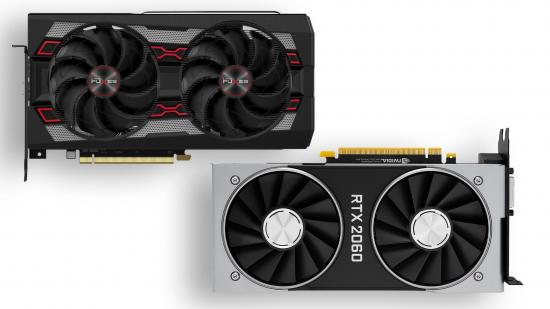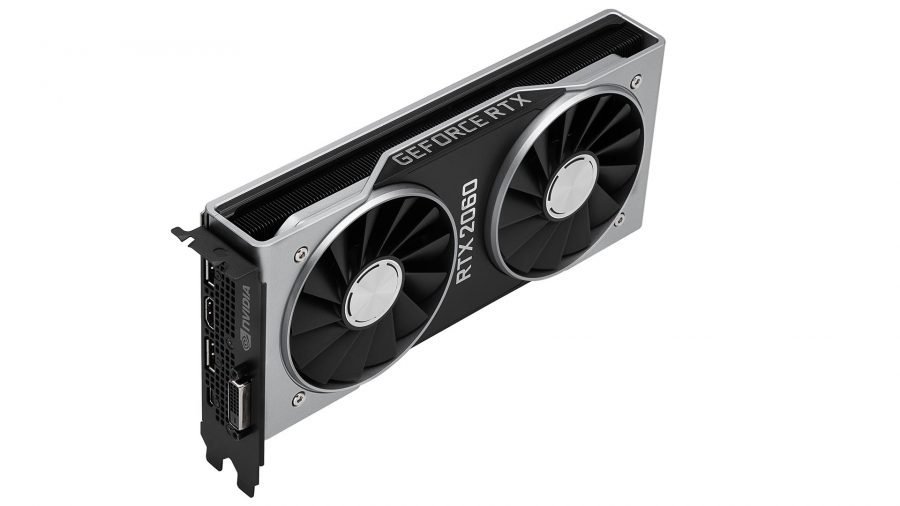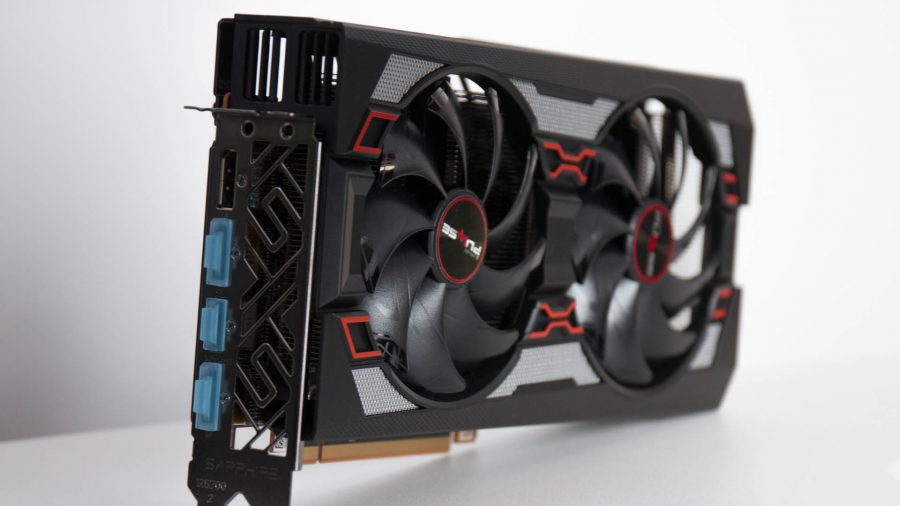If you’ve got $300 burning a hole in your pocket and an itch for new graphics card, it’s a question of Nvidia GeForce RTX 2060 vs. AMD RX 5600 XT – and which graphics card offers the best performance under $300. Fret not, we’ve gathered all the information you need for a fair and considered graphics card comparison.
It’s not an easy call to make. Both cards are specialised in very particular tasks and workloads. Take the RX 5600 XT, it’s a whizz at DX12 and handy at DX11, too. On the other hand, the RTX 2060 is your (economy class) ticket to a world of real-time ray tracing – and you won’t find that any place else but the RTX 20-series right now. You’ll have to decide whether you prefer raw in-game performance or next-gen rendering before you can rest easy knowing you came to the correct decision.
Now you may be wondering as to the fiscal RTX 2060 vs. RX 5600 XT match up on our hands here. Didn’t the RTX 2060 launch at $349? Yes, you’d be right. But the fear hit Nvidia pretty hard in the run-up to AMD’s RX 5600 XT launch, and it arbitrarily, some might say spontaneously, decided to work with its partners to drop RTX 2060 prices down to a convenient $299 – just $20 more than the RX 5600 XT MSRP.
That nets you the TU106 GPU housing 1,920 CUDA Cores, 30 RT Cores for real-time ray tracing acceleration, and 240 AI inference-busting Tensor Cores. Surrounding that mammoth 445mm2 die is 6GB GDDR6 memory via a 192-bit memory bus for 336GB/s bandwidth.
| RTX 2060 | RX 5600 XT | |
| GPU | TU106 | Navi 10 XTE |
| Cores | 1,920 | 2,304 |
| Base clock | 1,365MHz | From 1,375MHz |
| Boost clock | 1,680MHz | Up to 1,750MHz |
| VRAM | 6GB GDDR6 | 6GB GDDR6 |
| Memory bus | 192-bit | 192-bit |
| Memory speed | 14Gbps | 12-14Gbps |
| TDP | 160W | Up to 160W |
Nvidia RTX 2060 vs AMD RX 5600 XT
In return for Nvidia’s pricing parlour trick, AMD ripped up its CES slides and rewrote just about the RX 5600 XT’s entire specification sheet days prior to its release date. Whether AMD was purposefully being deceitful or not, the RX 5600 XT was first listed as a firm favourite to take down Nvidia’s GTX 1660 Ti in the high-end mainstream market. But that all changed in a moment’s notice.
At the epicentre of the RX 5600 XT is a Navi 10 GPU, near enough the same one featured within the RX 5700. That means 36 Compute Units containing 2,304 RDNA cores (not directly comparable in stature to CUDA cores), and kept well fed by a 192-bit memory bus connected to 6GB GDDR6 memory for an RTX 2060-equivalent 336GB/s bandwidth.
Turning around TSMC is no trifling matter, and AMD’s stuck with what it’s got in terms of hardware no matter what Nvidia brings to the party. Instead, AMD took a hacksaw to its stated clock speeds. From a max boost clock of 1,660MHz up to 1,750MHz, and memory overclocked from 12Gbps to 14Gbps, a new performance vBIOS firmware file released by AMD’s partners on order of the big cheese juiced many RX 5600 XT graphics cards up to monstrous proportions.
It’s important to note that not all RX 5600 XT firmware is created equal. Perhaps a symptom of AIB favouritism, only a few manufacturers were able to offer the full 1,750MHz boost clock paired with 14Gbps memory. The rest either had to settle closer to the original specification or build entirely new graphics cards fit for a fully-fledged glow up. Hence why, when you’re deciding between the RX 5600 XT vs. RTX 2060, be on the lookout for the models capable of delivering performance at the overhauled limits of the Navi 10 XLE GPU.
Our testing was carried out on the Sapphire RX 5600 XT Pulse, available for $289, and capable of the maximum out of the box GPU and memory clocks. We’ve also enabled the performance BIOS.
That all-important BIOS accounts for a 10% average performance delta between the RX 5600 XT and RTX 2060 in DX12 games during our in-house benchmarking. Without it, the RX 5600 XT would lose its advantage in Microsoft’s latest API, and even slip beneath the RTX 2060 in DX11, too.
The RTX 2060 manages marginal successes over the RX 5600 XT in DX11 titles. Nvidia’s last few architectures, including Turing, have proved themselves advantageous over raw AMD GCN parallel compute in Microsoft DirectX 11 titles. However, the RX 5600 XT isn’t GCN, it’s RDNA – a brand new architecture introduced with the RX 5700 series optimised for gaming and gaming alone. That’s perhaps why the RX 5600 XT manages to largely keep up with the RTX 2060 in AC: Odyssey and Far Cry: New Dawn, and only miss out in raw GPU benchmark Heaven.
When it comes to DX12 performance, it’s a different story. The RX 5600 XT surpasses its RTX counterpart in 3DMark Time Spy, Deus Ex: Mankind Divided, and Metro Exodus – often by some margin. This is the RX 5600 XT’s speciality, stunning DX12 performance like that which AMD is best known for.
Radeon Boost, introduced with the Adrenalin Software 2020 driver package, is another feather in the red team cap. This feature yoyos the rendered resolution during motion, easing the workload when you’ll notice the lack of fidelity least. It’s solid feature, and can dramatically improve performance in supported games.
Don’t write off the RTX 2060 just yet, however. Speaking of Metro Exodus, as you may recall it launched last year flying the RTX banner. Yes, real-time ray tracing. The RTX 2060 is the cheapest point of entry into the new world of realistic reflections, shadows, and lighting, and you’ll find no counterpart on team Radeon just yet. You’ll have to wait until RDNA 2 for that, or so they say.
But bear in mind the RTX 2060 is the bare minimum of RTX capabilities. Turning on ray tracing in-game won’t be a trivial decision – just take a look at our Metro Exodus and Call of Duty: Modern Warfare RTX performance reviews. You’ll no doubt sacrifice performance, and more often than not at this price point those frames per second will be too valuable to discard.
Nvidia RTX 2060 vs. AMD RX 5600 XT verdict
When it comes to RTX 2060 vs. RX 5600 XT, we favour the RX 5600 XT. This 7nm RDNA Navi 10 chip offers a tangible performance benefit in the latest DX12-enabled games, and while that’s not always necessary right now what with DX11 remaining exceedingly popular, it will see continued adoption in the years to come – in part due to wider DirectX ray tracing support pushed by, you guessed it, Nvidia.
The RX 5600 XT offers relative parity, with the exception of Heaven, to the RTX 2060 in DX11, too. In a package not the least bit as thirsty as its predecessors, and not nearly as loud either, we’re onto a stand-out winner.
But if you’re after real-time ray tracing right now, you’ve no other option at this price point than the RTX 2060. That’s just a fact of life until Q3 when we’re expecting movement from both Nvidia and AMD on next-gen ray tracing cards. While ray tracing prowess is a little more convincing as you creep into the high-end $500+ RTX 20-series graphics cards, at the RTX 2060 level, and with only a handful of RT Cores, it’s nowhere near as persuasive a feature.


